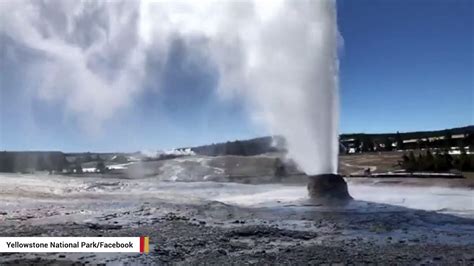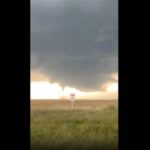
A recent eruption at Yellowstone National Park involving the Giant Geyser, one of the park’s largest, was captured on video, showcasing a powerful steam and water blast that reached significant heights.
Yellowstone National Park witnessed a significant eruption of the Giant Geyser on Sunday, an event captured by park visitors and shared widely on social media. The eruption, which sent plumes of steam and water high into the air, has drawn attention to the park’s ongoing geothermal activity and prompted discussions among scientists and park enthusiasts about the geyser’s behavior and potential implications.
The Giant Geyser, located in the Upper Geyser Basin, is known for its impressive but infrequent eruptions. Unlike Old Faithful, which erupts with predictable regularity, the Giant Geyser’s eruptions are sporadic and can vary significantly in intensity and duration. According to the National Park Service, the Giant Geyser’s eruptions can reach heights of over 200 feet, making it one of the tallest active geysers in the park.
“Giant Geyser is unpredictable, which adds to its mystique,” said a Yellowstone National Park spokesperson. “Its eruptions are a reminder of the dynamic geological forces at play beneath the park’s surface.”
The recent eruption, filmed by several visitors, showed a powerful burst of steam and water surging from the geyser’s cone. The footage quickly circulated on social media platforms, garnering thousands of views and sparking conversations about the significance of the event.
Geothermal Activity in Yellowstone
Yellowstone National Park is situated atop one of the world’s largest active volcanoes, a supervolcano that has shaped the region’s landscape and continues to influence its geothermal features. The park is home to over 10,000 hydrothermal features, including geysers, hot springs, mud pots, and fumaroles. These features are powered by the heat from the magma chamber beneath the surface.
The park’s geothermal activity is driven by the interaction of groundwater with the hot volcanic rock below. Water seeps into the ground and is heated by the magma. This superheated water then rises to the surface through cracks and fissures, creating the various hydrothermal features that characterize Yellowstone.
Geysers, like the Giant Geyser, are a unique type of hydrothermal feature. They are characterized by their ability to erupt periodically, shooting hot water and steam into the air. This occurs when water becomes trapped in underground chambers and is heated to temperatures above the boiling point. The pressure builds until it overcomes the surrounding rock, resulting in a dramatic eruption.
The Giant Geyser: A Closer Look
The Giant Geyser is one of the most impressive geysers in Yellowstone, though its eruptions are not as frequent as some of the park’s other geysers. Its eruptions are characterized by their height and power, often reaching over 200 feet. The geyser’s cone, formed by the accumulation of silica deposits over thousands of years, is a prominent feature in the Upper Geyser Basin.
The Giant Geyser’s eruption patterns have been studied extensively by scientists. While its eruptions are unpredictable, research has shown that they are influenced by factors such as groundwater levels, seismic activity, and changes in the park’s hydrothermal system.
“Understanding the factors that influence the Giant Geyser’s eruptions is crucial for monitoring the park’s overall geothermal activity,” said Dr. Emily Carter, a geologist specializing in Yellowstone’s hydrothermal systems. “Changes in eruption patterns can provide valuable insights into the behavior of the underlying volcano.”
Visitor Reactions and Safety Guidelines
The eruption of the Giant Geyser drew a large crowd of visitors, who were eager to witness the spectacle. Park rangers were on hand to ensure visitor safety and provide information about the geyser and its significance.
The National Park Service emphasizes the importance of following safety guidelines when visiting Yellowstone’s geothermal areas. Visitors are advised to stay on boardwalks and marked trails, as the ground around hydrothermal features can be unstable and the water can be scalding hot. It is also important to be aware of the potential for sudden eruptions and to maintain a safe distance from geysers and hot springs.
“Visitor safety is our top priority,” said the park spokesperson. “We urge everyone to follow the guidelines and be aware of the potential hazards in geothermal areas.”
The Broader Context of Yellowstone’s Volcanic Activity
Yellowstone’s geothermal features are a direct result of the underlying Yellowstone supervolcano. The volcano has erupted catastrophically three times in the past 2.1 million years, most recently about 640,000 years ago. These eruptions have had a significant impact on the landscape of North America, covering vast areas with ash and altering the course of rivers.
While the Yellowstone volcano is still active, scientists say that the probability of another catastrophic eruption in the near future is low. However, the volcano is constantly monitored for signs of unrest, such as changes in ground deformation, gas emissions, and seismic activity.
The Yellowstone Volcano Observatory (YVO), a partnership between the U.S. Geological Survey, the National Park Service, and the University of Utah, is responsible for monitoring Yellowstone’s volcanic activity. The YVO uses a variety of tools, including seismometers, GPS stations, and gas sensors, to track changes in the volcano’s behavior.
“The YVO provides critical information for assessing the potential hazards associated with the Yellowstone volcano,” said Dr. Jacob Miller, a volcanologist with the U.S. Geological Survey. “Our monitoring efforts help us to understand the volcano’s dynamics and to provide timely warnings if any signs of unrest are detected.”
The Role of Geothermal Features in Yellowstone’s Ecosystem
Yellowstone’s geothermal features are not only geological wonders, but also play an important role in the park’s ecosystem. The hot springs and geysers provide unique habitats for specialized microorganisms, such as thermophiles, which thrive in extreme temperatures. These microorganisms form the base of the food chain in these environments, supporting a diverse array of other organisms.
The geothermal features also influence the park’s hydrology, affecting the flow of water and the distribution of nutrients. The hot water from the springs and geysers can create localized areas of warmth and moisture, which can support plant growth even in the harsh winter months.
“Yellowstone’s geothermal features are an integral part of the park’s ecosystem,” said Dr. Sarah Johnson, an ecologist studying the park’s hydrothermal environments. “They provide unique habitats and influence the distribution of life in the park.”
Long-Term Monitoring and Research
The eruption of the Giant Geyser underscores the importance of long-term monitoring and research in Yellowstone National Park. Scientists continue to study the park’s geothermal features and volcanic activity to better understand the underlying processes and to assess potential hazards.
The National Park Service and its partners are committed to preserving Yellowstone’s unique geological and ecological resources for future generations. This includes protecting the park’s geothermal features, managing visitor use, and conducting research to inform management decisions.
“Yellowstone is a natural laboratory where we can learn about the Earth’s processes and the interactions between geological and biological systems,” said the park superintendent. “We are dedicated to protecting this special place and to sharing its wonders with the world.”
The recent Giant Geyser eruption serves as a potent reminder of Yellowstone’s dynamic nature, the immense geological forces at play beneath its surface, and the importance of continued observation and study. The event, while captivating for visitors, also provides valuable data for scientists seeking to understand the complex workings of this remarkable geothermal system.
FAQ: Yellowstone’s Giant Geyser Eruption
-
Q1: What caused the recent eruption of the Giant Geyser?
A1: The eruption was caused by the build-up of steam pressure underground. Water seeps into the ground and is heated by the magma. This superheated water then rises to the surface through cracks and fissures. When water becomes trapped in underground chambers and is heated to temperatures above the boiling point, the pressure builds until it overcomes the surrounding rock, resulting in a dramatic eruption. The precise triggers for each eruption can vary and are influenced by factors like groundwater levels and seismic activity.
-
Q2: How dangerous is the eruption of a geyser like the Giant Geyser to park visitors?
A2: The immediate danger is relatively low if visitors adhere to park safety guidelines. These include staying on boardwalks and designated trails, maintaining a safe distance from geothermal features, and being aware of the potential for sudden eruptions. The water and steam emitted during an eruption can be extremely hot, posing a scalding hazard if one gets too close. Additionally, the ground around geothermal areas can be unstable.
-
Q3: Is the eruption of the Giant Geyser an indication that the Yellowstone supervolcano is about to erupt?
A3: No, the eruption of the Giant Geyser is not necessarily an indication of an impending volcanic eruption. Geysers are a common feature of hydrothermal systems and are powered by heat from the magma chamber beneath Yellowstone, but they are distinct from volcanic eruptions. The Yellowstone Volcano Observatory constantly monitors the volcano for signs of unrest, such as changes in ground deformation, gas emissions, and seismic activity. As of now, there are no indications of an imminent volcanic eruption. The YVO states that the probability of a large volcanic eruption at Yellowstone remains very low.
-
Q4: How often does the Giant Geyser erupt?
A4: The Giant Geyser is known for its infrequent and unpredictable eruptions. Unlike Old Faithful, which erupts with predictable regularity, the Giant Geyser’s eruptions are sporadic and can vary significantly in intensity and duration. The intervals between eruptions can range from weeks to months, or even years.
-
Q5: What should visitors do if they witness an eruption of the Giant Geyser or any other geyser in Yellowstone?
A5: If visitors witness an eruption, they should maintain a safe distance, remain on designated boardwalks or trails, and follow the instructions of park rangers. It’s important to avoid approaching the geyser too closely, as the water and steam can be extremely hot. Enjoy the spectacle from a safe vantage point and respect the power and unpredictability of the geothermal feature. Report any unsafe conditions or behavior to park authorities.
Detailed Examination of Yellowstone’s Geothermal System
Yellowstone’s geological significance stems from its position atop a continental hotspot – a region where heat rises from deep within the Earth’s mantle. This hotspot is responsible for the park’s extensive geothermal activity and its history of large volcanic eruptions. Over millions of years, the hotspot has migrated across the North American continent, leaving a trail of volcanic calderas, with Yellowstone being the most recent and most active manifestation.
The park’s geothermal features are powered by a massive magma chamber located beneath the surface. This chamber, estimated to contain hundreds of cubic kilometers of molten rock, provides the heat source for the park’s geysers, hot springs, fumaroles, and mud pots. Water percolates down through fractures in the Earth’s crust, coming into contact with the hot rock and magma. This superheated water, under immense pressure, then rises back to the surface through a network of conduits.
The unique characteristics of Yellowstone’s geothermal features are determined by a variety of factors, including the depth and temperature of the heat source, the composition of the surrounding rock, and the availability of groundwater. Geysers, for instance, require a specific combination of factors to form: a heat source, a water supply, and a constriction in the underground plumbing that allows pressure to build.
The Giant Geyser exemplifies these conditions. Its cone is formed by the deposition of siliceous sinter (geyserite), a mineral that precipitates out of the hot, silica-rich water. The geyser’s complex internal structure includes narrow fissures and chambers where water can become superheated under pressure. When the pressure exceeds the strength of the surrounding rock, a violent eruption occurs, sending a plume of steam and water high into the air.
The Science of Geyser Eruptions
The mechanics of a geyser eruption are governed by the principles of thermodynamics and fluid dynamics. As water is heated deep underground, its temperature rises above the boiling point. However, the immense pressure at these depths prevents the water from boiling. As the superheated water rises, the pressure decreases, eventually reaching a point where the water can flash to steam. This rapid conversion from liquid to gas creates a surge of pressure that propels the remaining water out of the geyser’s vent.
The eruption continues until the underground chamber is depleted of superheated water. The geyser then enters a recharge phase, during which water slowly refills the chamber and the heating process begins anew. The duration of the recharge phase determines the interval between eruptions.
Scientists use a variety of techniques to study geyser eruptions, including temperature probes, pressure sensors, and high-speed cameras. These instruments provide valuable data on the dynamics of the eruption process, helping researchers to understand the factors that control geyser behavior.
Monitoring Yellowstone’s Volcanic Activity
The Yellowstone Volcano Observatory (YVO) plays a crucial role in monitoring the park’s volcanic activity and assessing potential hazards. The YVO is a collaborative effort involving the U.S. Geological Survey (USGS), the National Park Service (NPS), and the University of Utah. The observatory operates a network of monitoring instruments throughout the park, including seismometers, GPS stations, and gas sensors.
Seismometers are used to detect earthquakes, which can provide valuable information about the movement of magma beneath the surface. GPS stations measure ground deformation, which can indicate swelling or sinking of the Earth’s crust due to changes in magma pressure. Gas sensors monitor the release of volcanic gases, such as carbon dioxide and sulfur dioxide, which can provide clues about the activity of the magma chamber.
The data collected by the YVO’s monitoring network are analyzed in real-time to detect any signs of volcanic unrest. If unusual activity is detected, the YVO will issue alerts and warnings to the public and park officials. The YVO also conducts research to better understand the Yellowstone volcano and its potential hazards.
The Impact of Climate Change on Yellowstone’s Geothermal Features
Climate change is expected to have a significant impact on Yellowstone National Park, including its geothermal features. Changes in precipitation patterns, snowmelt, and temperature could alter the park’s hydrology, affecting the water supply to geysers and hot springs.
Some studies have suggested that increased evaporation rates due to higher temperatures could reduce the flow of water to geothermal features, potentially leading to a decrease in their activity. Other studies have indicated that changes in precipitation patterns could alter the timing and magnitude of geyser eruptions.
The long-term effects of climate change on Yellowstone’s geothermal features are still uncertain, but it is clear that these sensitive ecosystems are vulnerable to changes in the environment. The National Park Service is working to monitor the impacts of climate change on the park and to develop strategies to mitigate its effects.
Yellowstone’s Geothermal Features as Habitats for Extremophiles
Yellowstone’s geothermal features are home to a remarkable diversity of microorganisms, known as extremophiles, that thrive in extreme conditions. These organisms, including bacteria, archaea, and fungi, have evolved unique adaptations to survive in hot, acidic, or alkaline environments.
Thermophiles are organisms that thrive in high-temperature environments, such as hot springs and geysers. Some thermophiles can survive in temperatures above the boiling point of water. Acidophiles are organisms that thrive in acidic environments, such as mud pots and acidic hot springs. Alkaliphiles are organisms that thrive in alkaline environments, such as alkaline hot springs.
These extremophiles play a crucial role in the park’s ecosystem. They form the base of the food chain in geothermal environments, supporting a diverse array of other organisms, including invertebrates and vertebrates. They are also important for biogeochemical cycling, breaking down organic matter and releasing nutrients back into the environment.
The study of extremophiles in Yellowstone has led to important discoveries in biotechnology. Enzymes from thermophiles, for example, are used in a variety of applications, including DNA amplification and industrial processes.
The Cultural Significance of Yellowstone’s Geothermal Features
Yellowstone’s geothermal features have held cultural significance for Native American tribes for thousands of years. Many tribes, including the Crow, Shoshone, and Bannock, have traditional stories and beliefs associated with the park’s geysers, hot springs, and other geothermal features.
Some tribes used the hot springs for medicinal purposes, believing that the mineral-rich water had healing properties. Others considered the geysers to be sacred places, representing the power and mystery of the Earth.
The National Park Service is committed to working with Native American tribes to preserve and protect the cultural resources of Yellowstone National Park, including its geothermal features. This includes consulting with tribes on management decisions and providing opportunities for tribes to share their stories and traditions with park visitors.
The Giant Geyser eruption serves as a compelling illustration of the raw power and complex dynamics that characterize Yellowstone National Park. Its unpredictable bursts of steam and water highlight the ongoing geological processes shaping this unique landscape, reminding us of the delicate balance between nature’s forces and the ecosystems they support. Further study and diligent monitoring are essential to fully comprehend and safeguard this extraordinary environment for future generations.









